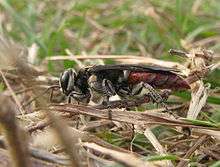Larra bicolor
Larra bicolor is a parasitoid wasp native to South America. It was introduced into Florida as a biological pest control of invasive mole crickets.
| Larra bicolor | |
|---|---|
 | |
| Scientific classification | |
| Kingdom: | |
| Phylum: | |
| Class: | |
| Order: | |
| Family: | Latreille, 1802 |
| Genus: | Fabricius, 1793 |
| Binomial name | |
| Larra bicolor (Fabricius, 1804) | |
Description
Adult females of this species are about 22 mm long, with the males somewhat smaller. The head and thorax are black, with silver markings on the head; the abdomen is red. The wings are variable in color, of a dusky hue.
Life cycle
These wasps feed on nectar as adults, with the shrubby false buttonweed (Spermacoce verticillata) preferred.[1] Females hunt mole crickets in the genus Scapteriscus, stinging them on the underside to paralyze them for several minutes. A single egg is deposited between the first and second pairs of legs. The wasp then flies off, and the cricket returns to its burrow. Nymphs as well as adult crickets are attacked, as long as they are large enough.
Upon hatching, the larva feeds upon its host, eventually killing it. It pupates within 12 to 30 days (depending on temperature), forming a cocoon in the remains of the cricket by gluing sand grains together. The pupal phase may be as short as 50 days, but the pupa may enter diapause in the winter, delaying emergence for months. Adults are solitary and do not form nests or colonies.
Other than the winter diapause mentioned above, there is no seasonal component to wasp activity. Several generations of wasps may occur in a year, one of the facets that allows these wasps to out-reproduce their hosts, an important attribute for a successful biological control agent.[2]
Biological pest control use
Non-native mole crickets arrived in Puerto Rico, at least as early as the 18th century, probably by flight,[3] and as early as 1899 in the southeastern United States, probably as contaminants of ship ballast. They became serious pests, damaging crops and pasture- and turfgrasses. Although the related L. analis attacks the native northern mole cricket, it does not attack non-native species. In an early example of biological pest control, L. bicolor was introduced into Puerto Rico in 1938, where it became successfully established. This suggested the possibility of its use on the mainland; however, failed attempts and the development of chlordane pesticide in the 1940s brought an end to these efforts.
When chlordane use on food crops was banned in 1978, the Florida legislature inaugurated a program at the University of Florida to find alternative controls for pest mole crickets. Budgetary limitations led to a repetition of the Puerto Rico to the mainland effort. But this population, which originated in Brazil, failed to establish itself except in an area around Fort Lauderdale. Research suggested that these wasps were insufficiently cold-tolerant, and a second effort in 1988-89 used wasps from Bolivia.[4] This introduction was much more successful, and the wasps have gradually spread through most of the state[5] and into neighboring states. They remain highly adapted to the non-native species and have not diversified to attack (for instance) the native northern mole cricket. Also, they are non-aggressive, and their sting is reported to be mild compared to more familiar wasps. The principal limitation in its use as a biological control agent has been the need to find appropriate nectar sources for the adults.[6] Research has found that some other plants, especially pentas,[7] are also found acceptable; nonetheless provision of suitable plants is necessary.
Citations
- Arévalo and Frank 2005
- Portman, Frank, McSorley and Leppla 2009
- Frank, Vicente and Leppla 2007
- Frank, Parkman and Bennett 1995
- Frank, Leppla, Sprenkel, Blount and Mizell 2009
- Portman, Frank, McSorley and Leppla 2010
- Held 2007
References
- Arévalo HA, Frank JH. 2005. Nectar sources for Larra bicolor (Hymenoptera: Sphecidae), a parasitoid of Scapteriscus mole crickets (Orthoptera: Gryllotalpidae), in northern Florida. Florida Entomologist 88: 146-151.
- Frank JH, Parkman JP, Bennett FD. 1995. Larra bicolor (Hymenoptera: Sphecidae), a biological control agent of Scapteriscus mole crickets (Orthoptera: Gryllotalpidae), established in northern Florida. Florida Entomologist 78: 619-623.
- Frank JH, Vicente NE, Leppla NC. 2007. A history of mole crickets (Orthoptera: Gryllotalpidae) in Puerto Rico. Insecta Mundi (2007) 0004: 1-10.
- Frank JH, Leppla NC, Sprenkel RK, Blount AC, Mizell III RF. 2009. Larra bicolor Fabricius (Hymenoptera: Crabronidae): its distribution throughout Florida. Insecta Mundi (2009) 0063:1-5.
- Held DW. 2007. Seasonal life history and suitability of horticultural plants as nectar sources for Larra bicolor, a parasitoid of mole crickets in the northern Gulf Coast. USGA Turfgrass and Environmental Research Summary.
- Portman SL, Frank JH, McSorley R, Leppla NC. 2009. Fecundity of Larra bicolor (Hymenoptera: Crabronidae) and its implications in parasitoid: host interaction with mole crickets (Orthoptera: Gryllotalpidae: Scapteriscus). Florida Entomologist 92: 58-63.
- Portman SL, Frank JH, McSorley R, Leppla NC. 2010. Nectar-seeking and host-seeking by Larra bicolor (Hymenoptera: Crabronidae), a parasitoid of Scapteriscus mole crickets (Orthoptera: Gryllotalpidae). Environmental Entomology 39: 939-943.
External links
- Larra wasps, mole cricket hunters on the UF / IFAS Featured Creatures Web site